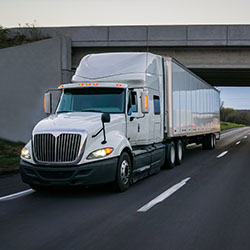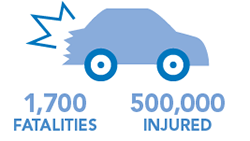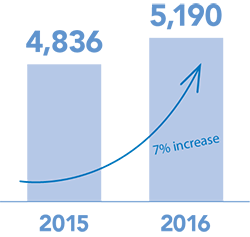Reduce the Risk of Workplace Injuries with Onboard Technology

Workplace injuries are a top concern for employers, and the U.S. Bureau of Labor Statistics has reported that fatal injuries are on the rise. Work injuries involving transportation incidents remained the most common fatal event in 2016, the latest year for which figures are available, accounting for 40 percent (2,083) of fatalities. What’s more, roadway collisions with other vehicles increased to 628 in 2016 from 525 in 2011, BLS reported.

Onboard technology can help those within the transportation industry mitigate the risk of injury on the job, and private fleets are adopting a number of safety features, ranging from in-cab cameras to air disc brakes.
“All of these technologies combined have an opportunity to enhance the ability to control a motor vehicle and it should make a driver’s job easier,” said Chuck Pagesy, director of safety for Penske Truck Leasing.
Collision Mitigation Technology and In-Cab Cameras
Collision mitigation systems use a camera positioned on the front of the vehicle as well as radar. The two systems work together to provide more active brake assistance and warnings, such as lane departure and blind spot detection. They also work to detect potential crash situations, such as when the distance between the truck and a vehicle gets too close. The systems alert drivers and take action automatically if drivers don’t react quickly enough.
The National Transportation Safety Board has reported that rear-end crashes kill about 1,700 people and injure 500,000 people annually. That rate would be reduced by 80 percent if vehicles were equipped with collision avoidance systems, the agency said.

NTSB has also recommended that private fleets deploy video system recorder technology to monitor drivers, saying the systems are a proactive tool to identify and reduce risky driving behavior, such as speeding, distracted driving or drowsy driving. Mike Hasinec, vice president of maintenance support for Penske Truck Leasing, said the cameras add a second degree of safety. “If a driver gets drowsy during a certain time of day, you can coach that,” he said.
Penske Logistics, for example, has installed SmartDrive event-triggered onboard cameras that face inside the truck cab and outwards to the road. “We’re able to review incidents and coach drivers to be better and safer drivers. We view this new program as an extension of the digital supply chain in our industry,” said Jason Herr, vice president of safety for Penske Logistics.
NTSB also said onboard video systems can provide valuable information for evaluating crashes. The systems can record video either continuously or as the result of a triggering event.
Hasinec said the cameras can also be used to clear a professional driver of fault in the event of a crash. “If an accident occurs that isn’t the truck driver’s fault, that camera helps prove the driver’s innocence,” he said. “Without a camera, it can be a ‘he said, she said’ conversation with a police officer. Without proof, it can get contentious.”
Daniel Grivej, a Penske Logistics operations manager in Flat Rock, Michigan, acknowledged that change does not come overnight. “I would say the drivers were hesitant at first, but now they consider it part of their job. I do think the cameras are an effective coaching tool,” he said.
Telematics/Onboard Data
Telematics, whether the technology is offered as a stand-alone device or as part of an electronic logging device (ELD) or Automatic or Automatic On-Board Recording Device (AOBRD), gives private fleets the opportunity to review a driver’s performance. The technology can often provide alerts for hard braking, also called sudden deceleration, or taking off quickly from traffic lights or stop signs, also called sudden acceleration. “They also have the capability to monitor vehicle speed,” Pagesy said, adding that fleets can receive real-time notifications or pre-scheduled alerts.
Pagesy said it is critical that fleets monitor information from telematics devices daily to address any event through coaching, mentoring and corrective counseling.
Lane Departure Warning Systems:
A lane departure warning system is a mechanism designed to warn the driver when the vehicle begins to move out of its lane (unless a turn signal is on in that direction). According to a AAA study, lane departure warning systems could potentially avert up to 6,372 crashes, prevent 1,342 injuries and eliminate 115 deaths per year.
Electronic Stability Control:
This technology works to minimize rollovers and crashes involving loss of control, which NHTSA said are responsible for 304 fatalities and 2,738 injuries on average each year. If the systems detect a vehicle is reaching its critical stability threshold, the technology kicks in and automatically reduces engine torque, applies the engine brake and activates the necessary wheel-end brakes, which reduces the likelihood of a rollover, jackknife or loss of control.
Automatic Braking:
Automatic braking is safety technology that spontaneously activates the vehicle’s brake system when sensors monitor the presence of vehicles ahead and around the vehicle or detect any situation where there’s an impending collision. According to the Insurance Institute for Highway Safety, automatic braking, or brake assist, is an integral component of crash avoidance technology. AAA states that emergency braking can prevent up to 5,294 crashes, 2,753 injuries and 55 deaths per year.
Air Disc Brakes:
Designed to improve the stopping distance of a vehicle, air disc brakes can prevent up to 2,411 crashes, 1,447 injuries and 37 deaths each year, according to the AAA study.
Air disc brakes can also minimize the risk of roadside violations. “Out of our fleet of 6,000 with air disc brakes, we never see a violation of brakes being out of adjustment. That is one of those soft value-adds,” Hasinec said. “Sometimes it is difficult to put a dollar amount from a return on that, but there are benefits.”

There were a total of 5,190 fatal work injuries recorded in the United States in 2016, the latest year for which numbers are available, the U.S. Bureau of Labor Statistics reported. That is a 7 percent increase from the 4,836 fatal injuries reported in 2015 and the first time more than 5,000 fatalities have been recorded by the Census of Fatal Occupational Injuries since 2008.
In 2016, fatal injuries among transportation and material moving occupations increased by 7 percent, to 1,388, the highest count since 2007 and accounting for more than one-quarter of all work-related fatalities.
June 2018

